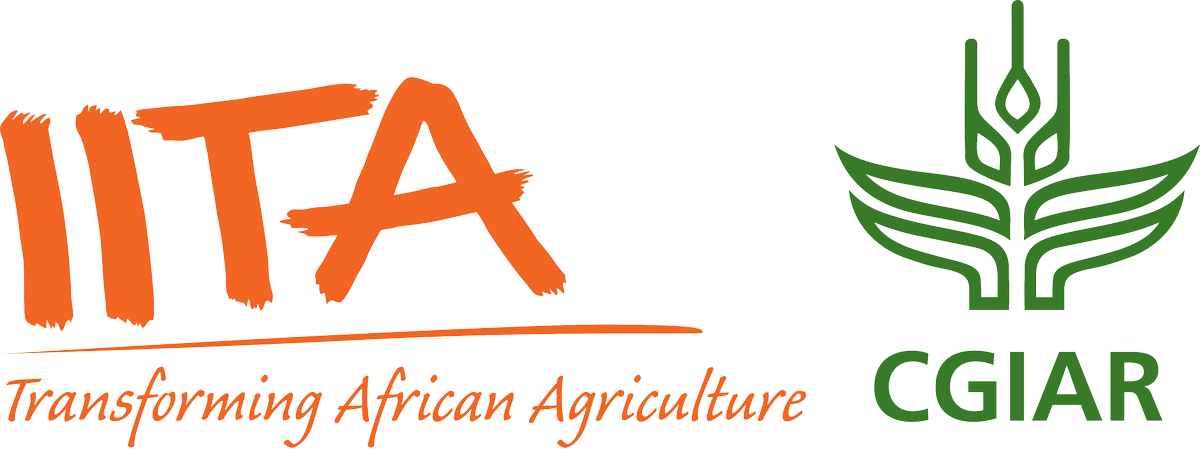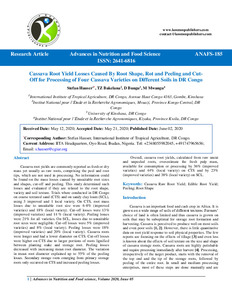| dc.contributor.author | Hauser, S. |
| dc.contributor.author | Bakelana, T.Z. |
| dc.contributor.author | Bungu, D. |
| dc.contributor.author | Mwangu, M. |
| dc.date.accessioned | 2022-04-19T09:06:33Z |
| dc.date.available | 2022-04-19T09:06:33Z |
| dc.date.issued | 2020 |
| dc.identifier.citation | Hauser, S., Bakelana, T.Z., Bungu, D. & Mwangu, M. (2020). Cassava root yield losses caused by root shape, rot and peeling and cut-off for processing of four cassava varieties on different soils in DR Congo. Advances in Nutrition and Food Science, 2020(5), 1-10. |
| dc.identifier.issn | 2641-6816 |
| dc.identifier.uri | https://hdl.handle.net/20.500.12478/7418 |
| dc.description.abstract | Cassava root yields are commonly reported as fresh or dry mass yet usually as raw roots, comprising the peel and root tips, which are not used in processing. No information could be found on the mass losses caused by unsuitable root sizes and shapes, cut-off and peeling. This study determined such losses and evaluated if they are related to the root shape, variety and soil texture. Trials where conducted in DR Congo on coarse textured sand (CTS) and on sandy clay loam (SCL), using 3 improved and 1 local variety. On CTS, root mass losses due to unsuitable root size were 6-8% (improved varieties) and 18% (local variety). Cut-off losses were 13% (improved varieties) and 14 % (local variety). Peeling losses were 21% for all varieties. On SCL, losses due to unsuitable root sizes were negligible. Cut-off losses were 5% (improved varieties) and 8% (local variety). Peeling losses were 18% (improved varieties) and 20% (local variety). Cassava roots were longer and had a lower diameter on CTS. Cut-off losses were higher on CTS due to larger portions of roots lignified between planting stake and storage root. Peeling losses decreased with increasing mean root diameter. The variation in mean root diameter explained up to 55% of the peeling losses. Secondary storage roots emerging from primary storage roots only occurred on CTS and increased peeling losses. Overall, cassava root yields, calculated from raw uncut and unpeeled roots, overestimate the fresh pulp mass, available for consumption or processing by 36% (improved varieties) and 44% (local variety) on CTS and by 23% (improved varieties) and 38% (local variety) on SCL. |
| dc.format.extent | 1-10 |
| dc.language.iso | en |
| dc.subject | Cassava |
| dc.subject | Yields |
| dc.subject | Peeling |
| dc.subject | Democratic Republic of the Congo |
| dc.subject | Peeling |
| dc.title | Cassava root yield losses caused by root shape, rot and peeling and cut-off for processing of four cassava varieties on different soils in DR Congo |
| dc.type | Journal Article |
| cg.contributor.crp | Roots, Tubers and Bananas |
| cg.contributor.affiliation | International Institute of Tropical Agriculture |
| cg.contributor.affiliation | Institut National pour l’Etude et la Recherche Agronomiques, DR Congo |
| cg.contributor.affiliation | University of Kinshasa |
| cg.coverage.region | Africa |
| cg.coverage.region | Central Africa |
| cg.coverage.country | Democratic Republic of the Congo |
| cg.coverage.hub | Eastern Africa Hub |
| cg.researchtheme | Natural Resource Management |
| cg.identifier.bibtexciteid | HAUSER:2020 |
| cg.authorship.types | CGIAR and developing country institute |
| cg.iitasubject | Agronomy |
| cg.iitasubject | Cassava |
| cg.iitasubject | Plant Breeding |
| cg.iitasubject | Plant Production |
| cg.journal | Advances in Nutrition and Food Science |
| cg.notes | Open Access Journal; Published online: 02 June 2020 |
| cg.accessibilitystatus | Open Access |
| cg.reviewstatus | Peer Review |
| cg.usagerightslicense | Creative Commons Attribution 4.0 (CC BY 0.0) |
| cg.targetaudience | Scientists |
| cg.iitaauthor.identifier | Stefan Hauser: 0000-0002-6329-7783 |
| cg.futureupdate.required | No |

